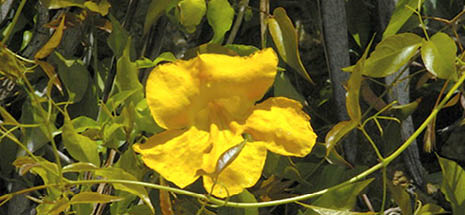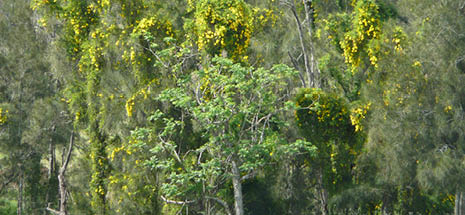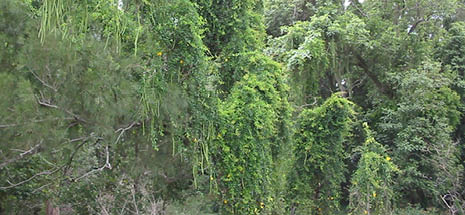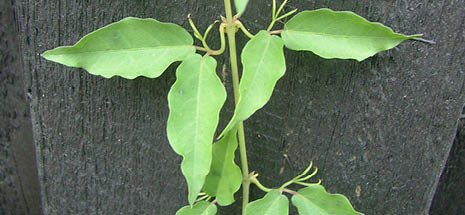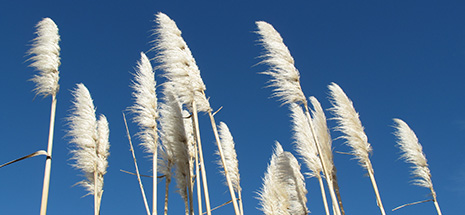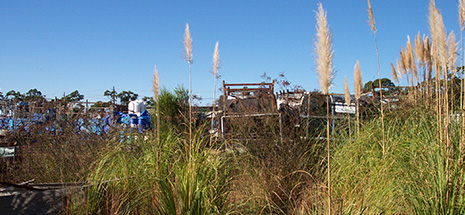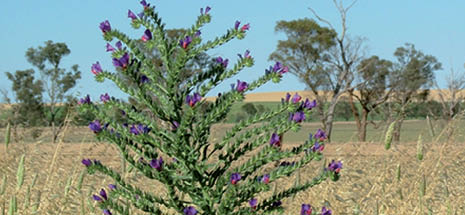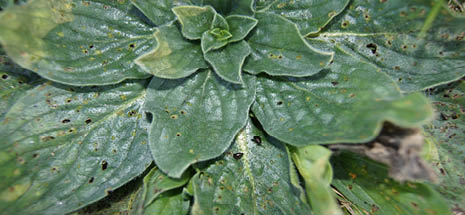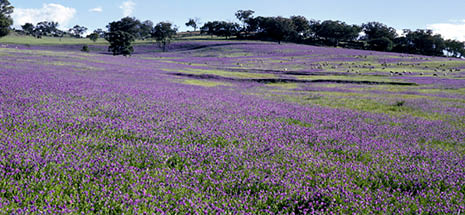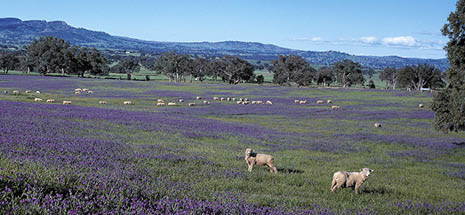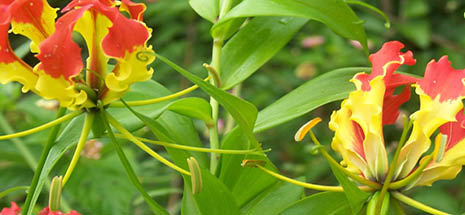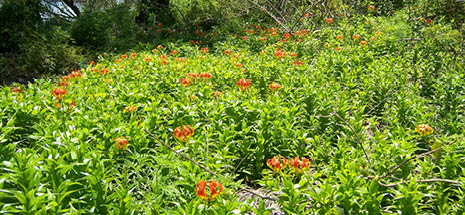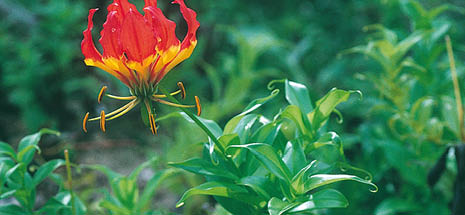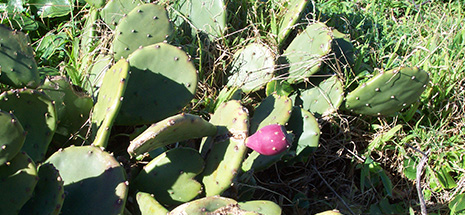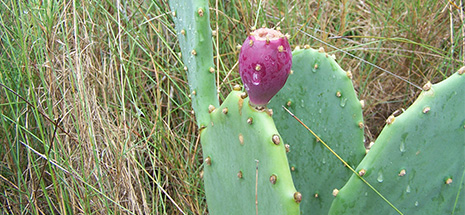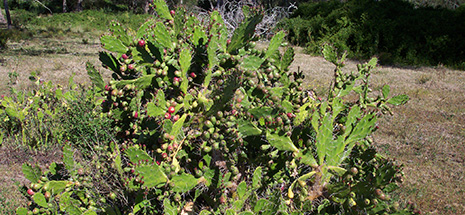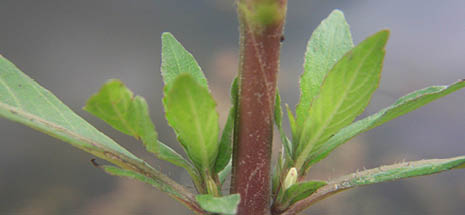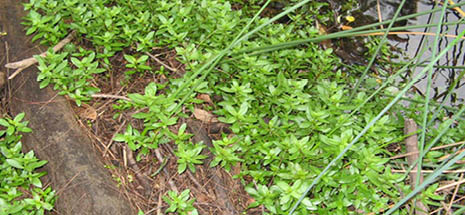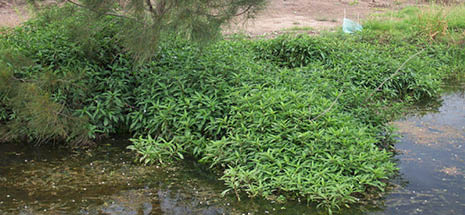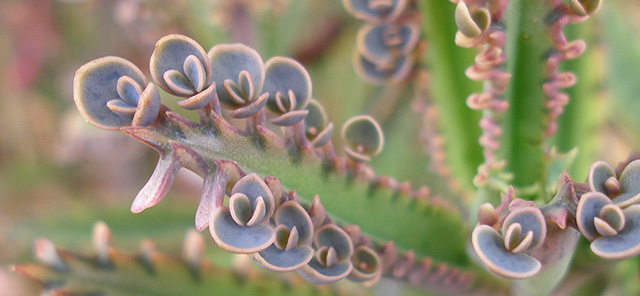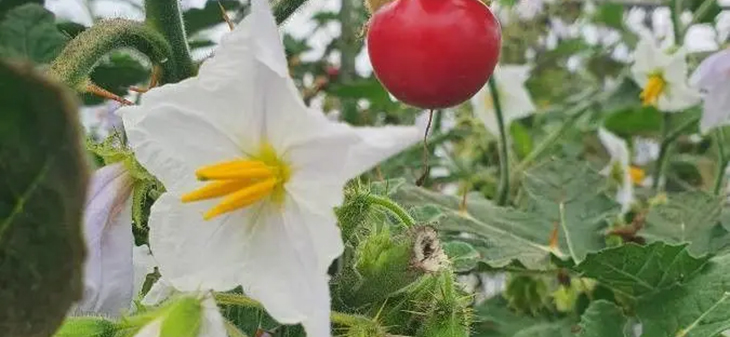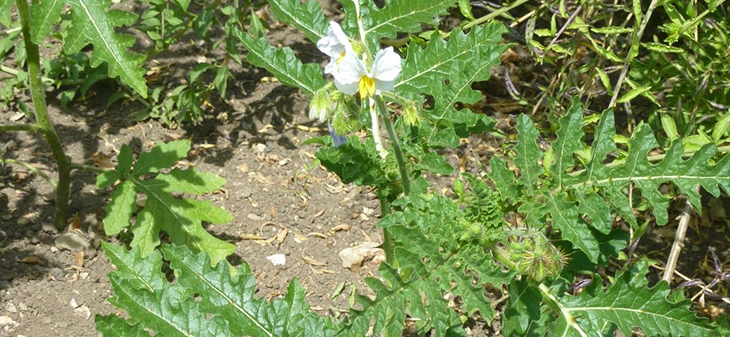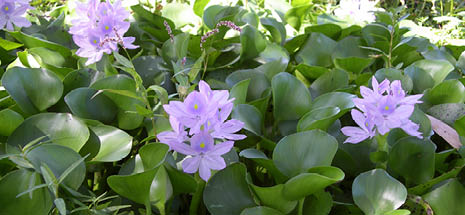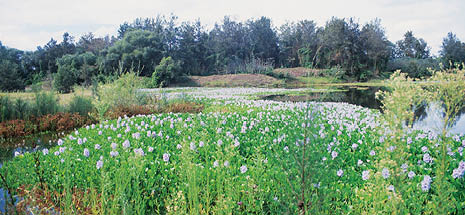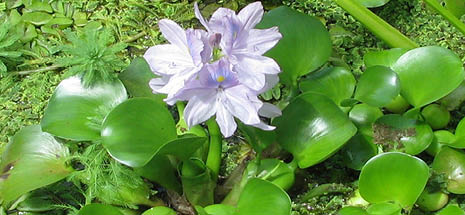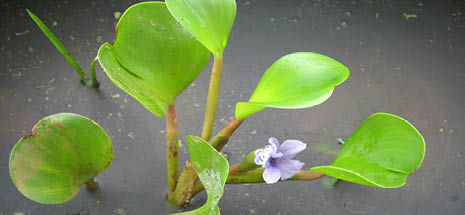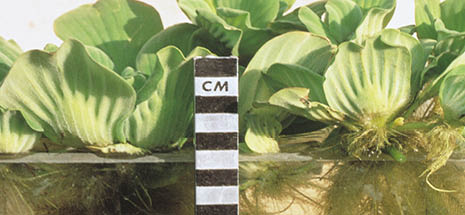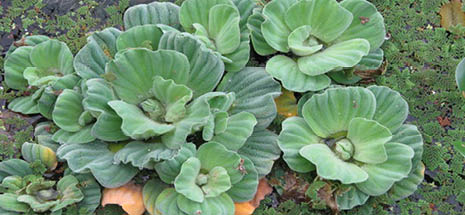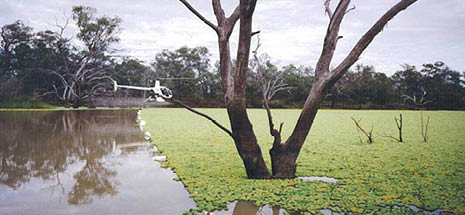Priority weeds
We work hard to keep our environment safe and as free from weeds as possible, so everyone can enjoy the incredible natural environment that Port Stephens has to offer.
African olive
(Olea europaea - subsp. cuspidata)
African olive is an invasive weed that is taking over properties across the Hunter and harbouring pests like foxes, rabbits and myna birds. Find out how you can help stop the spread of this nasty weed:
- check out our African Olive fact sheet (PDF 518 KB)
- visit WeedWise website.
Highly invasive weed in dry woodlands, riverine, coastal headlands and dunes. It out-competes native vegetation and prevents regeneration. African Olives aggressively invade cleared land, reducing the value and productivity of properties. They provide poor habitat for native animals and good habitat for feral birds such as Indian Mynas. If not controlled, the plant will take over large areas forming huge, dense monocultures of African Olive.
Seedlings can be hand pulled if all the roots can be removed. Beds of dense seedlings can be sprayed. More established plants will need to be cut and painted with herbicide (Roundup or Garlon). Apply herbicide mixture to cut surface as quickly as possible. For larger plants, inject herbicide into the stem or basal bark spray. The wood of African Olives is very hard, so ensure drilling or chiselling gets well into the stem.
Seeds are spread by birds and foxes. There is an current, significant infestation occurring in Hinton, Wallalong, Osterley and Brandy Hill.
Chinese violet
(Asystasia gangetica subspecies micrantha)
Chinese Violet is a national priority weed and is the subject of a Council eradication project. Almost all recorded infestations in Australia occur in Port Stephens. For more information:
- check out our Chinese Violet fact sheet (PDF 852KB)
- visit WeedWise website.
Cats Claw Creeper
(Dolichandra unguis-cati)
Cat's claw creeper has escaped gardens to become a major weed of native forests and riparian areas in eastern Australia.
It competes with native plants by forming a dense above-ground mat and numerous underground reproductive tubers.
Its climbing woody stems (lianas) cling to tree trunks, enabling it to grow into the forest canopy. In native rainforests it can overtop and kill mature trees, opening up the canopy for light-loving weeds.
Dense infestations of cat's claw creeper are very difficult to control due to its numerous lianas, abundant seed and ability to resprout from the tubers, sometimes for years.
Weeding should proceed gradually as creation of large gaps can lead to further weed invasion. Follow up is essential.
Your local council weeds officer will assist with identification, control information and removal of this weed.
Even seedlings and small plants have tubers that are difficult to dig out.
Cats claw creeper can be most effectively controlled by employing the 'cut stump' technique and applying a registered herbicide such as, Picloram 44.7 g/kg + Aminopyralid 4.47 g/L eg Vigilant II ®. Always refer to the label prior to use.
Seed pods mature in late summer to autumn and seeds start dropping from the vines in late May. Most seeds fall in July and August. Seed viability is low but seed production is high and some seeds produce multiple seedlings. The winged seeds can be blown in the wind and spread by water along streams and rivers. Established plants can reproduce from tubers and stems. The tubers can be spread in flood waters or by machinery if the soil is disturbed.
Photos courtesy of the NSW Department of Primary Industries.
Pampas grass
(Cortaderia species)
While it is not yet a major weed in NSW, our efforts are focused on ensuring this weed does not take hold.
Once established, the plant is very competitive, restricting the establishment of native trees, and can become a fire hazard and harbour vermin.
Pampas grass is of greatest potential weed significance to forestry operations. However, it has not yet become a major problem in NSW forests, as such preventative measures are essential.
It has a root system up to 3.5m deep. The tussock produces large quantities of flammable material. It is very competitive with native plants.
Pampas grass is readily grazed by stock when it is young, before it becomes too abrasive. This prevents the development of flowers and seed set.
Your local council weeds officer will assist with identification, control information and removal of this weed.
Residents can employ the use of a registered herbicide in order to control this weed, such as; Glyphosate 360 g/L eg Roundup®. Always refer to the label prior to use.
In many cases, garden plants are the seed source for infestations. Individual plants have the ability to produce vast quantities of windborne seed — up to 100,000 per flower head, which can infest areas within a 25km radius.
Paterson's Curse
(Echium Plantagineum)
Reduces Pasture Productivity and is toxic to livestock.
Can degrade the natural environment, comprising habitat values by crowding out and suppressing native vegetation.
Decreases value of hay and grain contaminated with it.
Affects human health. Some people are allergic to the pollen and the rough hairy texture of the leaves and stems causes skin irritation in people having close contact with the plant.
Preventing Paterson’s curse from spreading to uninfested areas should be given a high priority. Once it becomes established in an area it is extremely difficult to eradicate. Paterson’s curse spreads only through the movement of seeds; therefore methods which prevent seed moving to uninfested areas should be employed.
It is a prolific seeder that can produce more than 5000 seeds per plant per year.
Your local council weeds officer will assist with identification, control information and removal of this weed.
Residents can employ the use of a registered herbicide in order to control this weed, such as; Picloram 100 g/L + Triclopyr 300 g/L + Aminopyralid 8 g/L eg Grazon Extra® and Dicamba 500 g/L eg Kamba® 500. Always refer to the label prior to use.
Paterson's curse reproduces by seed. It is commonly spread via contaminated hay and grain, livestock droppings and machinery. It is a prolific seeder that can produce more than 5000 seeds per plant per year. Large quantities of seeds may accumulate in the soil over several years. For example, a seedbank of up to 30 000 seeds per square metre has been reported. Seeds may remain dormant in the soil for up to five years.
Photos courtesy of the NSW Department of Primary Industries.
Glory Lily
(Gloriosa superba)
Can form dense understorey carpets in dune systems along the coast, competing strongly with native flora.
Glory lily also compromises bitou bush control programs because, once the bitou bush is removed, glory lily can form a dense understorey.
All parts of the glory lily are highly toxic and has been responsible for the poisoning of both humans and livestock.
Dumping garden waste in bushland or allowing these garden plants to spread out of control in gardens close to natural bushland areas, creates a major threat of further infestations.
Your local council weeds officer will assist with identification, control information and removal of this weed.
Residents can employ the use of a registered herbicide in order to control this weed, such as; Glyphosate 360 g/L eg Roundup® and Glyphosate 360 g/L with Metsulfuron-methyl 600 g/kg (Various products). Always refer to the label prior to use.
Each plant can produce over 1000 seeds. The seeds remain in the soil over winter and germinate in spring. Seeds may be spread by birds. Glory lily also grows from tubers and rhizome fragments. People dumping garden waste is the main way that plants have spread to new areas.
Photos courtesy of the NSW Department of Primary Industries.
Prickly Pear and Tiger Pear
(Cylindropuntia and Opuntia species)
There are many different Prickly pear species — in Port Stephens, our focus is on the Opuntia species. This Weed of National Significance must not be sold in NSW.
Spreads by seed or vegetatively by segments which root where they contact the ground. The plant invaded large areas of northern NSW and central Queensland in the early 1900s and was infesting some 25,000,000 hectares.
Currently only minor occurrence exist within the Port Stephens LGA, as such preventative measures are essential.
Common pest pear is largely controlled by the biological control cactoblastis, Cactoblastis cactorum. In areas where cactoblastis cannot complete 2 generations per year, it can be controlled by the biological control cochineal, Dactylopius opuntiae.
Your local council weeds officer will assist with identification, control information and removal of this weed.
Residents can employ the use of a registered herbicide in order to control this weed, such as; Triclopyr 600 g/L eg Garlon® 600 and Picloram 100 g/L + Triclopyr 300 g/L + Aminopyralid 8 g/L eg Grazon Extra®. Always refer to the label prior to use.
Most spread in Australia has been by humans — either as garden plants and hedges — or through dumping in rubbish tips or bushland.
Vegetative spread is the most common form of dispersal. This can happen year round when segments, immature fruit or flowers detach and make ground contact. Segments can easily spread by attaching to clothing, footwear or the fur of animals.
Hygrophila
(Hygrophila costata)
Hygrophila is a highly invasive aquatic weed. It grows up to 1.5 m high in shallow water, forming mats of dense growth around the margins of freshwater lakes, rivers and watercourses where it can dominate and out-compete other vegetation.
Dense infestations are likely to displace native flora and fauna by destroying their natural habitat.
It can also interfere with recreational activities such as boating and access to the water’s edge.
Your local council weeds officer will assist with identification, control information and removal of this weed.
Residents can employ the use of a registered herbicide in order to control this weed, such as Glyphosate 360 g/L (Only products registered for aquatic use, eg Roundup Biactive®). Always refer to the label prior to use.
Control of hygrophila is very difficult as new infestations can form from any remaining pieces of the plant.
Reproduction is by either seed or stem fragments. Spread occurs when seeds and plant fragments attach to animals, machinery or watercraft, or are dispersed by wind or water. As such good hygiene practices, such as washing down boats before leaving the area, play an essential role in controlling this weed.
Plants have been spread by people dumping aquarium or pond plants in waterways. Seed is also distributed by water, animals, wind and watercraft.
Plants can grow from cuttings or severed leaves. Leaves can sprout roots if they are left floating on the water’s surface. Stem fragments sprout new roots when they come in contact with the soil.
Photos courtesy of the NSW Department of Primary Industries.
Mother of millions
(Bryphyllum species)
Mother of millions is a drought hardy succulent garden plant. It rapidly produces tiny plant-lets that quickly form new colonies. All species and hybrids of Bryophyllum are declared noxious weeds.
As the name suggests, mother of millions reproduces rapidly, producing hundreds of tiny plantlets which quickly form new colonies. It is adapted to dry conditions and can survive long periods of drought.
Is toxic to humans and household pets with dogs being particularly susceptible. It is unlikely that humans or pets would eat enough plant material to become poisoned. However, because mother of millions can be found in many gardens, the likelihood of human or pet poisoning is increased.
Your local council weeds officer will assist with identification, control information and removal of this weed
Preventing the spread of mother of millions is the best control measure. Regularly check for it in winter when the plants are in flower and are easier to see. If found remove immediately using a combination of control methods including hand removal and herbicide application. Hand removed plants should be stored in black plastic bags until decayed or buried.
Residents can employ the use of a registered herbicide in order to control this weed, such as Fluroxypyr 333 g/L eg Starane™ Advanced or Picloram 100 g/L + Triclopyr 300 g/L + Aminopyralid 8 g/L eg Grazon Extra®. Always refer to the label prior to use. Always add a wetting agent.
As the name suggests, Mother of millions reproduces rapidly — producing hundreds of tiny plantlets which quickly form new colonies.
Sticky nightshade
(Solanum sisymbriifolium)
Sticky Nightshade decreases productivity through competition with crops and pastures.
Supresses the growth of native plants.
Sharp prickles covering the leaves and stems threaten people, pets, livestock and native wildlife.
Contains toxic organic compounds resulting in sickness and death to livestock if digested in high quantities.
Not to be mistaken for native, naturally occurring Forest nightshade (Solanum prinophyllum).
Your local council weeds officer will assist with identification, control information and removal of this weed.
Growth is fast with flowering occurring 5 weeks after germination. Early detection and rapid prevention of spread offer the greatest chance for successful control.
The proximity of hanging fruits to the ground reduces the effectiveness of slashing. Chemical applications fail to terminate viable seeds which must be removed from the plant prior.
Residents can employ the use of a registered herbicide in order to control this weed, such as;
Triclopyr 300g/L + Picloram 100g/L with Metsulfuron-methyl 600g/kg and Glyphosate 360g/L with Metsulfuron-methyl 600g/kg. Always refer to the label prior to use.
Seeds primarily dispersed through ingestion by animals and movement of contaminated soil. Seed production varies between individuals, averaging 159.9 seeds per fruit.
Mature individuals are able to persist in unfavourable weather through rhizomes underground.
Water Hyacinth
(Eichhornia crassipes)
Water hyacinths are one of the world’s worst aquatic weeds. It infests rivers, dams, lakes and irrigation channels on every continent. It devastates aquatic environments and costs billions of dollars every year in control costs and economic losses.
It forms dense, impenetrable mats over the water surface, destroying natural wetlands, restricting recreational use of waterways, reducing aesthetic values of waterways, reducing water quality and changes the temperature, pH and oxygen levels of water.
Your local council weeds officer will assist with identification, control information and removal of this weed
Most spread can be attributed to human activity such as the deliberate planting of water hyacinth in ornamental ponds or dams. Water hyacinth can also be spread by contaminated boating equipment.
Early detection and rapid response offer the greatest likelihood of successful control and the opportunity for eradication. It is essential that any new infestations are controlled as soon as possible. In NSW, a number of herbicides are registered for the control of water hyacinth such as Glyphosate 360 g/L eg Roundup Biactive® or Metsulfuron-methyl 600 g/kg eg Brush-off®. Always refer to the label prior to use.
The seeds are released from the capsule underwater. Each capsule has between 40 and 300 seeds. The seeds either sink or accumulate in the floating plant mat. Seed remains viable for up to 20 years in mud or soil. Seeds can be moved to new locations by water flows or via mud stuck to birds, machinery and footwear.
Water hyacinth infestations increase most rapidly by producing new daughter plants. Each plant can produce 2-4 daughter plants. Most of these are produced in spring to summer. During high water flows and flooding, plant masses can break up and move to new locations.
Photos courtesy of the NSW Department of Primary Industries.
Water Lettuce
(Pistia stratiotes)
Tourism and recreation are affected when water lettuce limits recreational activities, reduces aesthetic values and increases mosquito populations.
Water lettuce can quickly form mats over the water surface, destroying natural ecosystems and blocking irrigation equipment.
Rivers, wetlands, lakes, reservoirs and other slow-moving streams are most affected by this species. Water lettuce can survive for long periods on muddy banks or in other damp locations such as roadside culverts.
To manage water lettuce you should contact the Invasive Species team if you see an infestation so they can help control it. For small isolated infestations, these can be physically removed and bagged, however It's important to take care to prevent the spread of plant parts when moving this species.
Herbicide treatments should be considered when managing large infestations, utilizing a registered herbicide. Contact the Invasive Species team for suggestions on herbicide, as the use of certain products is determined by the specific situation that the plant occurs.
The seeds germinate in early summer once temperatures rise above 20°C. Then the new seedlings float to the surface. The buoyant seedlings can move further downstream. Seeds create ongoing problems in infested areas. Water lettuce grows all year round.
Each plant produces daughter plants. Each daughter plant then produces its own daughter plants, forming dense mats. When broken up, each plant, or even pieces of plants, can start to grow a new mat. Water lettuce used to be sold at nurseries or pet shops as ‘water rose’. It’s still found in some ponds and dams. Floods can spread these plants to new areas.
Photos courtesy of the NSW Department of Primary Industries.
Alligator weed
(Alternanthera philoxeroides)
Tolerant plant with a potential to persist within aquatic and terrestrial environments. Dense mats comprised of leaves and stems can form up to 1m thick floating on the water surface. This restricts sunlight penetration and gaseous exchange, resulting in de-oxygenated conditions displacing native flora and fauna.
Prolific growth rates influence the movement of sedimentation consequently exacerbating flooding, which increases habitat availability for mosquitoes. Dense mat infestations ranging from 2m2 to 10m2 can reduce water flow by 50%.
Fragmented plants move through irrigation infrastructure causing blockages and contamination of crops and pastures.
Palatable to livestock which increases sensitivity to sunlight, resulting in skin lesions, liver damage and death when excessive amounts are consumed.
Due to a natural resistance to herbicides, a triannual chemical application program has been established. Greater success in removal has been demonstrated if applied during the growing season. Please visit NSW Weedwise for more information.
Successful mechanical removal requires all roots and individual associated stems to be thoroughly removed. Vegetative material should be dried, incinerated, boiled or microwaved then disposed into general waste, not green waste or compost.
Flea beetle (Agasicles hygrophila) was introduced in 1976 as a biological control. Limitations arise due to the beetles preference for warm temperate and subtropical climates, in addition to increasing fragmentation and downstream spread. No biological control has been successful in reducing terrestrial populations.
Your local council weeds officer will assist with identification, control information and removal of this weed.
Residents can employ the use of a registered herbicide in order to control this weed, such as; Carfentrazone-ethyl 240 g/L, Glyphosate 36 g/L or Imazapyr 250 g/L. Always refer to the label prior to use.
Individuals reproduce through fragmentation opposed to seed in Australia. Any fragment possessing a node is capable of regenerating.
Primarily spread between NSW catchments through the movement of excavation machinery, boats, sand dredged and turf from infested areas. Machinery operating within infested areas should be thoroughly cleaned and inspected prior to movement.
Not to be mistaken with Mukunuwenna (Alternanthera sessilis), Wandering trad (Tradescantia fluminensis) or native species Lesser joyweed (Alternanthera denticulate).
Black locust
(Robinia pseudoacacia)
All parts of the plant are poisonous to humans and livestock due to the production of robin and robitin proteins. Ingestion induces nausea, vomiting, diarrhoea, dizziness, convulsions, breathing difficulties and drowsiness lasting for several days. Deadly to horses known to cause demise within hours after consumption.
Has been recorded to live to 100 years, producing seed between 6 - 60 years old. Seeds possess high survivorship and a dormancy of up to 88 years due to a hydrophobic, impenetrable waxy coating. Species is fast growing and thrive after disturbance which can competitively exclude native species.
Alters nitrogen cycle within the environmental system. This exacerbates excess nitrogen-based issues including decreased soil pH and increased nutrient run off promoting eutrophication around water systems.
Not to be confused with invasive species Honey Locust (Gleditsia triacanthos) or Tree of Heaven (Ailanthus altissima)
Your local council weeds officer will assist with identification, control information and removal of this weed.
For success in manual removal of small plants, ensure the entire sucker has been removed.
Individuals under 4m can be treated with a foliar spray. Larger individuals can be removed though basal barking, cut stump and stem injection techniques. Slashing and brush cutting may supress growth but not terminate the plant and can encourage seed growth beneath by increasing available sunlight.
Residents can employ the use of a registered herbicide in order to control this weed, such as; Glyphosate 360 g/L with Metsulfuron-methyl 600g/kg or Fluroxypyr 200 g/L. Always refer to the label prior to use.
Disperses primarily through root suckers and seed. Extensive root systems can radially extend 1-1.5 x the height of the plant and have been recorded to reach 25m deep in optimal environmental conditions.
Bridal creeper
(Asparagus asparagoides)
Invasive vine which forms a thick mat of stem, rhizomes and tubers. 87% of the plants total mass survives below ground. This smothers native species such as the endangered Pimelea spicata, reduces successful establishment of native seedlings and limits availability of soil nutrients and moisture to competing native species.
Agricultural yield and productivity are reduced through suffocation of cultivated species.
Plant is able to withstand suboptimal environmental conditions through an underground network of tubers and rhizomes. Tolerant of frequently disturbed sites such as roadsides and drains.
Three species have been released into Australia as a biological control including the bridal creeper leaf hopper (Zygina spp), rust fungus (Puccinia myrsiphylli) and leaf beetle (Crioceris spp). The leaf hopper and rust fungus have each been released at 700 different sites nationwide.
Physical removal is achievable in small infestations, however ineffective unless all of the rhizomes have been removed from the soil. Slashing stems can prevent the production of fruit but will not eradicate the infestation due to the persistence of rhizomes. Individuals should be bagged and solarised for minimum two months prior to disposal.
Your local council weeds officer will assist with identification, control information and removal of this weed.
Residents can employ the use of a registered herbicide in order to control this weed, such as; Glyphosate 360 g/L or Metsulfuran-methyl 600 g/kg. Always refer to the label prior to use.
One square meter of plant can produce more than 1000 berries, each containing two or three seeds which can persist dormant in the soil for three years. Birds, rabbits and foxes ingest and spread seeds. Seeds are typically spread from 500m to 12km from the parent. Individuals additionally arize from the rhizomes.
Broad leaf pepper tree
(Schinus terebinthifolia)
Toxic to humans and livestock. Sap contains urushiols, a natural synthesised resin which induces skin conditions such as severe itching, lesions, rashes, oozing sores, ulcers, welts, swollen faces, haemorrhages in the eyes and breathing difficulties.
Harbours disease including mango black spot and witches broom diseases detrimental to citrus cultivars.
Forms dense thickets which suffocate native species and dominate understorey vegetation. Thrives after disturbance and in nutrient poor conditions.
Not to be confused with the invasive Pepper tree (Schinus mole var. areira)
Your local council weeds officer will assist with identification, control information and removal of this weed.
Seedlings may be removed manually if personnel protective clothing is worn and contact with the sap is avoided.
Chemical applications include a foliar spray at the early fruiting stage. Trees can be basal barked if the stem base diameter ranges up to 5cm thick and minimum 30cm tall. Cut stump and stem injection methods additionally may be effective.
Residents can employ the use of a registered herbicide in order to control this weed, such as; Fluroxypyr 333 g/L or metsulfuron-methyl 75g/kg + Aminopyralid 93.7 g/kg. Always refer to the label prior to use.
Originally introduced as an ornamental garden plant.
Primarily dispersed through seed ingestion by birds and frugivores. This process increases the success rate of germination. Individual plant can produce over 1000 seeds per m2 annually, seeds remain viable in the soil for up to 9 months.
Felled trees may induce the growth and reproduction from suckers for up to 18 months after.
Cabomba
(Cabomba caroliniana)
Fast growing, entirely submerged aquatic weed which chokes water ways and causes blockages leading to issues surrounding channels and irrigation infrastructure. It promotes siltation and reduces water flow. This alters the water quality through changing colour, promoting pungent odours and accumulation of organic matter.
Blocks sunlight for other aquatic species inducing an anoxic environment toxic to native aquatic species. Additionally promotes mosquito breeding habitat.
Dense canopies form underwater which threatens swimmers with entanglement.
Not to be confused with invasive Parrot’s feather (Myriophyllum aquaticum) or Hornwort (Cabomba caroliniana)
Your local council weeds officer will assist with identification, control information and removal of this weed.
Difficulty arises with chemical applications due to potential to harm non-target species. Additionally, some resistance to herbicide has been displayed and may take up to 9 months to eliminate the plant.
Residents can employ the use of a registered herbicide in order to control this weed, such as; Carfentrazone-ethyl 240 g/L or Flumioxazin 15 grams /tablet. Always refer to the label prior to use.
Requires permanent, moderately slow moving, shallow water for survival. Draining water sources and allowing the plant and soil to completely dry out can eliminate the population. If soil remains damp there is a 50% chance the infestation will return.
Small and isolated infestations may be controlled physically with divers or permanently shading the weeds due to a requirement for direct sunlight. An infestation can be supressed by aquatic weed harvesters however as the roots remain intact, the plant will continue to grow. Boats, trailers, machinery and fishing equipment must be thoroughly cleaned and inspected prior to movement.
Aquatic weevil (Hydrotimetes natans) has been identified as a potential biological control.
Distributed as an aesthetic aquarium plant. In 1999 cost estimates control for this species around $500,000 annually.
Highly fragment which can survive up to 8 weeks without anchoring into sediment. A fragment as small as 10mm with one pair of leaves can grow into a mature plant. Does not produce viable seed in Australia.
Relocated via movement of inadequately cleaned fishing, boats, trailer equipment and water flows from infested environments.
Cape broom
(Genista monspessulana)
Seeds relatively toxic to humans and grazing live stock due to the production of the nitrogenous organic compound cystine. Induces nausea, convulsions and respiratory failure if ingested in excessive amounts.
Reduces productivity and carrying capacity of pastures and native areas by forming dense, impenetrable thickets. These competitively exclude cultivars and native species while harbouring favourable habitat for feral animals such as rabbits and foxes.
Nitrogen fixing species which increases soil suitability for greater germination of offspring and encourages other invasive species. It shades under-storey species including excludes grasses and ground cover species which increases soil erosion.
Increases the ground litter fuel load exacerbating bushfire intensity and frequency. Heat from a fire triggers a break in seed dormancy resulting in dense germination and growth following.
Begins to produce seed at 2 years old, mature plants can individually produce 12,000 seeds annually. Dense infestations may contain 100,000 seeds per square meter within the soil. Seeds remain viable and dormant within the soil for up to 30 years.
Not to be mistaken with native Golden tip (Goodia lotifolia).
Apply control measures prior to flowering and seeding for best results.
Chemical application methods include foliar spraying to smaller individuals, cut stump treatments, scrape-and-paint, basal barking for individuals over 30cm tall and with a base circumference under 50mm diameter and stem injections for bases over 50mm circumference.
Your local council weeds officer will assist with identification, control information and removal of this weed.
Residents can employ the use of a registered herbicide in order to control this weed, such as; Picloram 100 g/L + Triclopyr 300 g/L + Aminopyralid 8 g/L or Picloram 44.7 g/L + Aminopyralid 4.47 g/L. Always refer to the label prior to use.
Isolated, small populations can be mechanically removed however difficulty arises with eliminating seeds form the soil and therefore require long-term follow up.
Cape broom psyllid (Arytinnis hakani) has been identified as a biological control.
Introduced to Australia as an ornamental garden plant.
Seeds are dispersed through birds and livestock as well as contaminated agricultural produce, farm machinery, vehicles and earth moving equipment.
Seed pods open explosively which can eject seeds up to 4 meters.
Climbing asparagus
(Asparagus africanus)
Inhibits development of native species by forming dense thickets and mats above and below ground. This smothers grasses and ground cover species while preventing establishment of seedlings. Is capable of climbing up to 12 meters to suffocate taller trees.
Able to tolerate a wide range of environmental conditions including highly disturbed areas such as roadsides and waste areas.
Can produce fruit after one year old. One individual plant can produce up to 21000 seeds which remain viable in the soil for up to 3 years.
Your local council weeds officer will assist with identification, control information and removal of this weed.
Residents can employ the use of a registered herbicide in order to control this weed, such as; Picloram 44.7 g/L + Aminopyralid 4.47 g/L. Always refer to the label prior to use.
Small infestations of seedlings can be removed manually. Crowning techniques can reduce the plant mass while minimizing disturbance to the soil however without complete removal of the crown the plant may continue to regrow.
Initially introduced to Australia as a garden plant.
Seeds often dispersed by birds, reptiles and foxes as well as water flows and movement of contaminated land.
Growth can occur from rhizomes as well as seeds.
Climbing asparagus fern
(Asparagus plumosus)
Smothers larger plants up to 5 meters tall and increases chances of branches falling.
Highly competitive and fast growing forming dense mats which displace native species.
Toxic to pets including dogs, cats and horses due to the synthesis of steroid sapogenin. May result in dermatitis with repeated exposure or gastric issues including vomiting, abdominal pain or diarrhea if berries are ingested.
Not to be confused with invasive species Climbing asparagus (Asparagus africanus) or Edible asparagus (Asparagus officinalis).
Small and isolated individuals may be hand removed. Ensure the entirety of the roots including the crown has been removed otherwise the plant will regrow.
Your local council weeds officer will assist with identification, control information and removal of this weed.
Residents can employ the use of a registered herbicide in order to control this weed, such as; Fluroxypyr 200 g/L, Glyphosate 360 g/L or Metsulfuron-methyl 600 g/kg. Always refer to the label prior to use.
Reproduces via seeds, fragments or rhizomes.
Regenerative parts are spread by birds and contaminated machinery.
Coral creeper
(Barleria repens)
Competitive species forming dense thickets which replace, supress and smother native species up to 2m tall.
Hardy plant which can tolerate a broad range of environmental and climate conditions including frequently disturbed areas. This facilitates domination over a wide variety of regions increasing ecological impact.
Your local council weeds officer will assist with identification, control information and removal of this weed.
Individual plants can be mechanically pulled.
Residents can employ the use of a registered herbicide in order to control this weed, such as; Fluroxypyr 200 g/L, Metsulfuron-methyl 600 g/kg and Glyphosate 360 g/L. Always refer to the label prior to use.
Explosive release of seeds from the fruit propelling a few meters. Each berry contains 4 seeds. Seeds covered in fine hairs which facilitate dispersal capacity by stick on to people and animals, increasing dispersal capacity.
Primarily spread through water flows, animals and movement of contaminated soil.
Frogbit
(Limnobium laevigatum)
Forms large dense mats over the surface of the water limiting recreational activities.
Induces anoxic waters by reducing light penetration and gaseous exchange resulting in uninhabitable waters for native species.
Causes blockages within waterways and irrigation infrastructure.
Reduces water flows resulting in increased breeding habitat for mosquitoes.
Not to be confused with invasive Backer (Hydrocharis dubia).
Your local council weeds officer will assist with identification, control information and removal of this weed. Do not attempt to treat or control of the plant yourself without notifying your local council weeds officer.
Residents can employ the use of a registered herbicide in order to control this weed, such as; Glyphosate 360 g/L or Flumioxazin 15 grams /tablet. Always refer to the label prior to use.
Initially introduced into the wild through dumped aquarium matter.
Leafless branches stretching 50cm long fragment and release a daughter plant at the terminal. Seeds remain viable for minimum 3 years.
Predominately moved through water flows. Inadequately cleaned machinery and birds facilitate transfer from an infested site to another water body.
Galenia
(Galenia pubescens)
Tolerant to drought and salt, which enables establishment over coastal dunes and other frequently disturbed or neglected areas.
Bees are attracted to the flowers, however the nectar collected will alter the flavour of the honey to become unpalatable.
Fast growth rate with one individual growing 2-3 meters in diameter within a single year. Roots can reach 2 meters underground.
Forms dense mats which smother and suppress native species leading to biodiversity loss. River red gums (Eucalyptus camaldulensis) seedling populations have been notably reduced.
Increases soil nitrates and soluble oxalates which increases toxicity to stock in fertile soils. Roots are able to reach 2 meters underground.
Not to be confused with native Berry saltbush (Atriplex semibaccata).
Small, isolated infestations may be physically removed. Ensure the majority of the root is removed from the soil otherwise plant will continue to regrow.
Your local council weeds officer will assist with identification, control information and removal of this weed.
Residents can employ the use of a registered herbicide in order to control this weed, such as; Picloram 100 g/L + Tricopyr 300 g/L + Aminopyralid 8 g/L. Always refer to the label prior to use.
Seeds are dispersed by wind, birds, water and movement of contaminated soil.
One mature plant is capable of producing up to 5,000 seeds annually. Dense infestations may possess up to 100,000 seeds per m2 within the soil.
Groundsel bush
(Baccharis halimifolia)
Forms dense thickets which outcompete native species and reduce the carrying capacity of pastures. Can establish in a wide variety of habitats including saltmarshes, wetlands, semi-tidal areas, forests, waste areas, pastures and disturbed sites. Tolerates pH ranging from 3.8 to 8.2.
Poisonous to livestock if ingested in large quantities due to the synthesis of a sugar compound glycoside saponin. Can be fatal if an individual digest over 2% of their body weight. Females more toxic than males.
Triggers hay fever and allergies.
May be mechanically pulled. Slashing prior to flowering can reduce seed production. Frequent slashing may eventually kill the bush.
Since 1967, 35 various species have been tested as a biological control. Six insects and rust fungus have permanently established within NSW, the Gallfly (Rhopalomyia californica), and stem boring beetle (Megacylene mellyi) are the most effective.
Your local council weeds officer will assist with identification, control information and removal of this weed.
Various chemical application techniques can be employed including splatter guns, basal barking, foliar spray and cut stump methods.
Residents can employ the use of a registered herbicide in order to control this weed, such as; 2,4-D 300 g/L, Clopyralid 600 g/L or Glyphosate 360 g/L. Always refer to the label prior to use.
One female bush is able to produce 1.5 million seeds per year which remains viable in the soil for two years and typically fall within 150m from the parent. Seeds may be spread further through wind, water, machinery and movement of contaminated soil.
Additionally can regrow from roots if not correctly removed.
Kidney-leaf mud plantain
(Heteranthera reniformis)
Creates blockages in dams, drains, water supply channels and irrigation infrastructure.
Reduces gaseous exchange and light penetration within the water which promotes anoxic waters and limits habitat availability for native species.
Increases breeding habitat for mosquitoes.
Seeds can persist in the soil for 15 years until germination is triggered by temperature fluctuations and water availability.
Small, isolated infestations can be physically removed with care to prevent fragmentation.
Your local council weeds officer will assist with identification, control information and removal of this weed.
Residents can employ the use of a registered herbicide in order to control this weed, such as; Metsulfuron-methyl 660 g/kg or Glyphosate 360 g/L. Always refer to the label prior to use.
Seeds are winged which facilitates wind and water dispersal. Partially distributed by catching on machinery and birds moving from an infested location.
One stem fragment with a single pair of leaves is capable of producing a new plant.
Ludwigia
(Ludwigia peruviana)
Alters water flows increasing the risk of flooding. Limits gaseous exchange and sunlight penetration reducing habitat availability for native species.
Restricts recreational activities.
Creates blockages in dams, drains, water supply channels and irrigation infrastructure.
Not to be confused with native Water primrose (Ludwigia peploides subsp. montevidensis) or Willow primrose (Ludwigia octovalis) species.
Plants may be mechanically pulled and disposed of through burning or deep burial. Species relies on direct sunlight therefore shading individuals may reduce germination and growth.
Your local council weeds officer will assist with identification, control information and removal of this weed.
Residents can employ the use of a registered herbicide in order to control this weed, such as; Glyphosate 360 g/L or Picloram 44.7 g/L + Aminopyralid 4.47 g/L. Always refer to the label prior to use.
Disperses by seed and fragmentation. Seed is produced within 18 months from germination, while germination can occur after 4 days seed release. One pod may hold up to 4000 seeds to which over 80% are viable.
Primarily spread through water flows, wind, birds and machinery.
Individuals can additionally rise from fragmented stem or roots.
Salvinia
(Salvinia molesta)
Inhibits recreational activities.
Blocks water flows and irrigation infrastructure which increases breeding habitat for mosquitoes.
Limits gaseous exchange and light penetration which induces anoxic waters and displaces native species.
Tolerant of dry periods and brackish waters by forming a dense mat which protects the buds.
Small and isolated infestations may be removed by hand. Managing water flows and diverting effluent reduces the nutrient content of the water creating suboptimal conditions.
Primary biological control includes Salvinia weevil (Cyrtobagous salviniae). Control efforts may take 6 weeks to 2-3 years depending on the environmental conditions. 30 °C is optimal for breeding efforts, temperatures under 20°C significantly reduce the breeding rate while under 17 °C completely inhibit.
Your local council weeds officer will assist with identification, control information and removal of this weed.
Residents can employ the use of a registered herbicide in order to control this weed, such as; Metsulfuron-methyl 600 g/kg, Carfentrazone-ethyl 240g/L or Glyphosate 360 g/L. Always refer to the label prior to use.
Individuals can rise through fragmentation and daughter plants, which are sections of stem that develop buds. Spores are not viable in Australia.
Primarily spread through water flows, wind, birds and infested boats and machinery improperly cleaned before moving to new site.
Scotch broom
(Cytisus scoparius subsp. scoparius)
Reduces productivity and carrying capacity of pastures and native areas by forming dense, impenetrable thickets. These competitively exclude cultivars and native species while harbouring favourable habitat for feral animals such as rabbits and foxes.
Synthesises toxic alkaloids in the seeds and leaves which induce high blood pressure and nausea in humans, livestock and native wildlife when ingested.
Increases the ground litter fuel load exacerbating bushfire intensity.
Nitrogen fixing species which alters soil composition to favour offspring and other invasive species.
Your local council weeds officer will assist with identification, control information and removal of this weed.
Integrated management plans are crucial for lasting control, this can include a combination of fire, hand pulling, slashing, grubbing, chemical and biological treatment. Seed germination is triggered by fire therefore follow up treatments are necessary for at least five years. Individuals are able to regrow from underground vegetative matter.
Several biological controls persist within NSW including Scotch boom gall mite (Aceria genistae), Twig mining moth (Leucoptera spartifoliella), Scotch broom psyllid (Arytainilla spartiophila) and Seed beetle (Bruchidi villosus). Scotch broom gall mite demonstrates the greatest success in control but is limited by cooler conditions.
Residents can employ the use of a registered herbicide in order to control this weed, such as; Glyphosate 360 g/L or Picloram 100g/L + Triclopyr 300 g/L + Aminopyralid 8 g/L. Always refer to the label prior to use.
Originally brought into NSW as an ornamental garden plant.
Primarily spread through spread of contaminated soil and machinery, water flows, birds and wildlife.
Seed pods explosively burst shooting seeds meters away. One individual is capable of producing 10,000 seeds annually which can remain viable in the soil for several decades.
Sea spurge
(Euphorbia paralias)
Reduces nesting area availability for threatened shorebird species.
Alters land morphology and ecological processes including sedimentation and erosion patterns of sand movement.
Milky sap is toxic to people and animals which irritates skin and eyes on contact. Ingestion of excessive quantities can result in renal complications.


